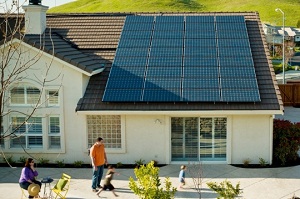California has installed over 1 gigawatt of photovoltaics on homes and businesses
 California’s been the leader in installed solar in the U.S. for a long time. And with giant projects starting to come online later this year, its likely to remain the leader. But earlier this month, with little fanfare that state also announced it hit another milestone—more than 1 gigawatt of solar has been installed on homes and small businesses.
California’s been the leader in installed solar in the U.S. for a long time. And with giant projects starting to come online later this year, its likely to remain the leader. But earlier this month, with little fanfare that state also announced it hit another milestone—more than 1 gigawatt of solar has been installed on homes and small businesses.
The California Public Utilities Commission (CPUC) issued its 2012 California Solar Initiative (CSI) Annual Program Assessment in early July. The report found that by the end of the first quarter of 2012, 1.26 gigawatts of photovoltaics were installed at 122,516 sites across the state. The report found that the rates at which solar was being added in was increasing significantly as well. It found there was a 38 percent increase in solar capacity and a 29 percent increase in the number of properties going solar as compared to the same period a year before.
The CSI program had a goal of adding in 1.94 gigawatts of solar by the end of 2016, but that might come earlier. “We expect that the General Market program may exceed its target of 1,750 megawatts (and yes that would be fine),” said CPUC spokesperson Terrie Prosper. “We also expect that SASH [i.e., Single-Family Affordable Solar Homes Program] and MASH [i.e., Multi-Family Affordable Solar Homes Program] will not reach their combined target of 190 megawatts,” she said.
While there are no plans to raise the amount of solar installed through the $2.4 billion program, Prosper that may be a bad thing. “The goal of the program is to grow solar into a sustainable market, so we hope the desire to go solar continues long after the program expires,” she said.
A recent finding by CPUC also should help consumers continue to install solar, perhaps even after the CSI program is fulfilled. That’s because the state recently ruled that utilities had to change how they calculated net-metering, requiring that they add in more residential solar than they initially anticipated having to.
The report also found that a significant driver of the expanded customer-sited generation has been because of third-party ownership (TPO) models. Such models include leases and power-purchase agreements through net-metered systems. Both CSI incentives like SASH and TPO models also made it easier for middle- and lower-income homeowners to go solar. The report found those were the fastest-growing sectors with low-income installations increasing 364 percent since 2007 and middle-income, rising 445 percent since 2007.



